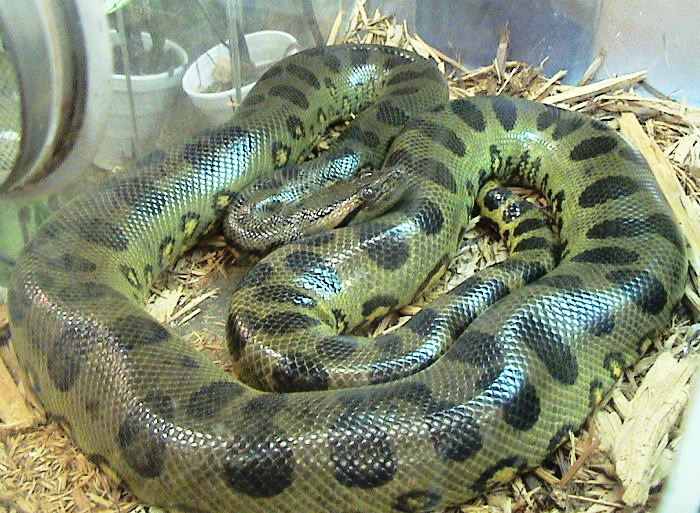 |
| Green anaconda in captivity Photo by LA Dawson |
Adult green anacondas are 20 feet in length, on average. However, they can grow up to 29 feet in length, or more. Reticulated pythons can grow to be longer than the green anaconda, but they are nowhere near as heavy. Adult green anacondas weigh an average of 330 pounds and can grow to weigh up to 550 pounds, or more. It’s no wonder that many humans are afraid that these massive beasts could eat them. In truth, they are capable of eating humans that are not too large. However, anaconda attacks on humans are rare and no fatal cases have been proven.
These snakes mate in a very interesting way. The female, which is significantly larger than the male, will lie in wait for males during the later months of the dry season. Several males, anywhere between two and twelve, will coil around the female in a “‘breeding ball” for several weeks. Once the female has mated with her partners, she will go up to seven months without eating. Gestating for roughly six months, she will retain her eggs, which incubate for eight to twelve weeks. She gives birth to dozens of live young that are roughly 1-2 feet in length. They are completely independent from birth and can be expected to live about ten years in the wild. However, green anacondas have been known to live up to thirty years in captivity.
Green anacondas feed on a variety of mammals, reptiles, amphibians, fish and birds. They can eat rather large prey, such as wild pigs, capybara, jaguars and deer. They coil around their prey and squeeze it until it can no longer breathe and subsequently dies. They then swallow their prey whole. Like many snakes, they can go for a long time without eating, depending on the size of their most recent meal. It is extremely rare for an adult green anaconda to be consumed by another animal. However, adolescents of the species may be preyed upon by some mammals, birds and reptiles.
Despite their obviously formidable appearance, green anacondas are quite beautiful. They are commonly dark green in color with black, oval-shaped markings. These markings have yellowish centers on the sides of the snake. They can be admired from afar in several zoos and aquariums. This may be the best way to catch a glimpse of these awesome creatures.
Sources
Green Anaconda, retrieved 11/17/09, seaworld.org/animal-info/Animal-Bytes/animalia/eumetazoa/coelomates/deuterostomes/chordata/craniata/reptilia/squamata/green-anaconda.htm#top
Green Anaconda, retrieved 11/17/09, neaq.org/animals_and_exhibits/animals/anaconda/index.php
Soomro, A. 2001 “Eunictus murinus,” Animal Diversity Web, retrieved 11/17/09, animaldiversity.ummz.umich.edu/site/accounts/information/Eunectes_murinus
No comments:
Post a Comment